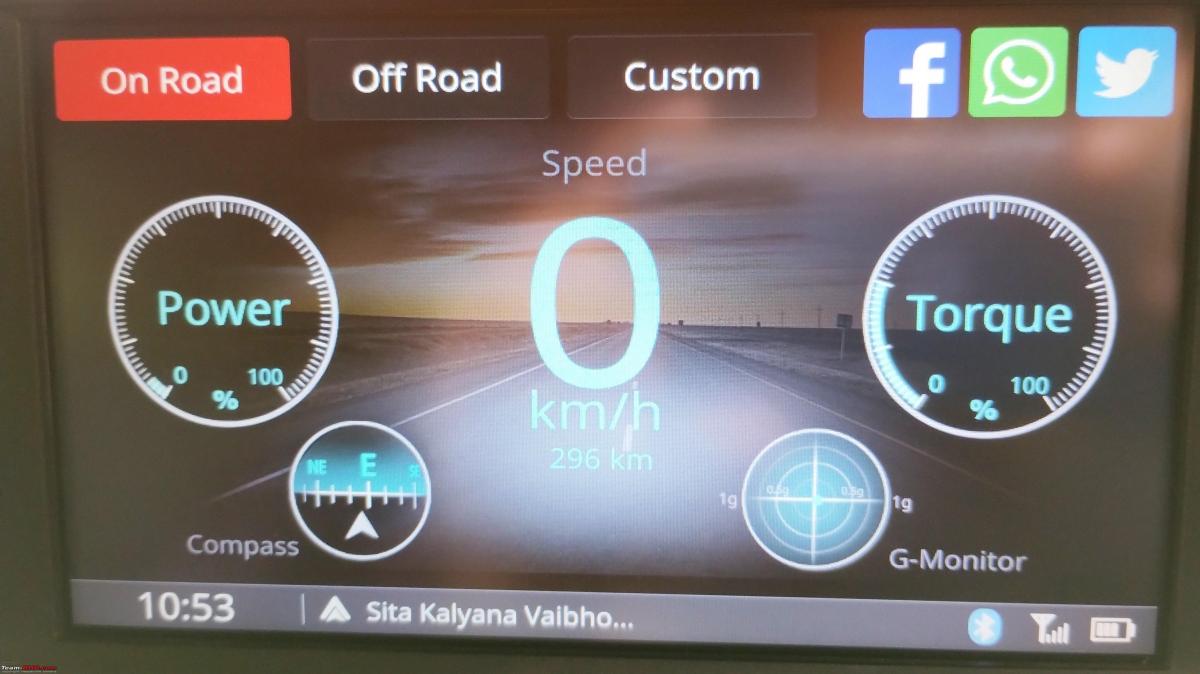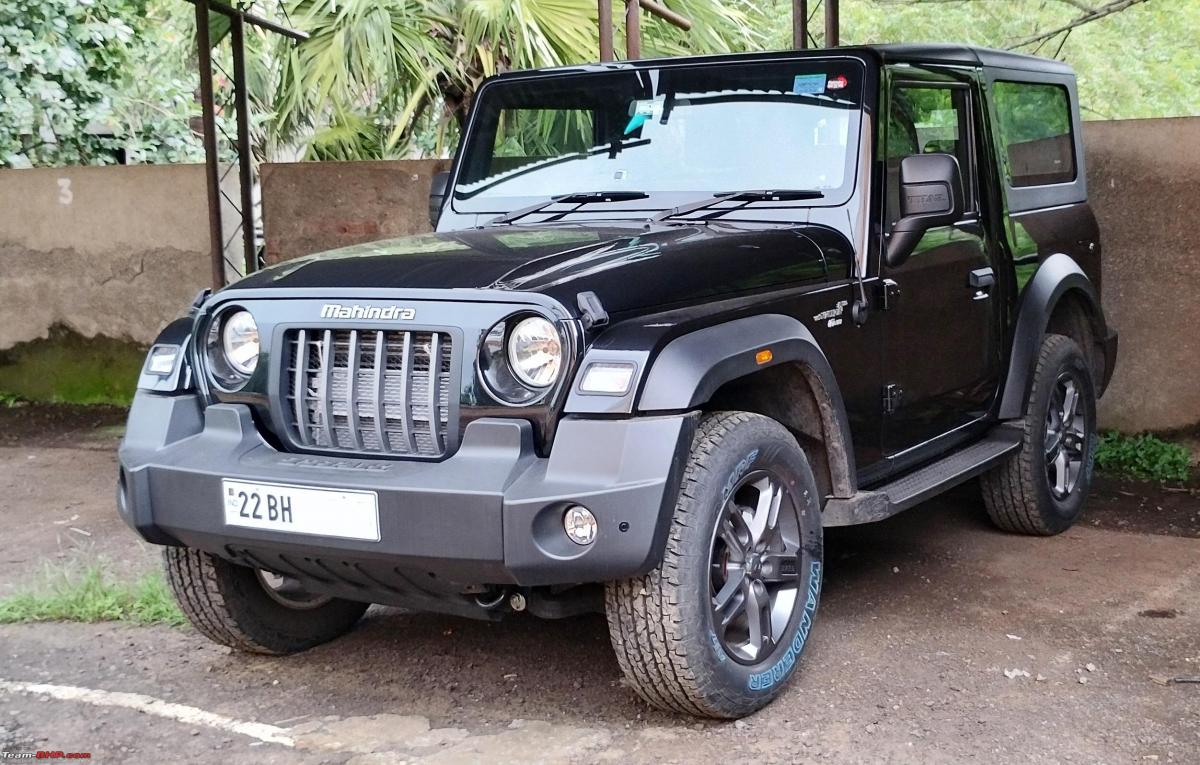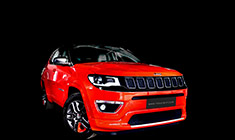News
My 2022 Mahindra Thar petrol: Delivery, accessories & 1st impressions
The hard-top SUV replaced my 2015 XUV500, which I managed to sell for a good deal.
BHPian arunpools recently shared this with other enthusiasts.
This is my first post here. Thank you very much Team-BHP for accepting my membership request.
I have been following Team-BHP threads for a long time now. This place helped me a lot with my XUV 500 purchase decision back in 2015. Today, I’m happy to report the arrival of my new Mahindra Thar. This time also Team-BHP forum has been of much help.
Until now, I have been an observer and read through the threads and took quality advice. Now that I’m a member, I thought I might also contribute my thoughts and experiences. What better way to start here than a post on my new ride?
The Bright Idea
My craze for the new Thar started when I saw a Black Convertible zip past my 2015 XUV 500 at breakneck speeds a couple of months back. I did not know Thar could do that. My experience with the old Thar was not a pleasant one when I test-drove it some 7 years back. When I saw the new Thar doing speeds that I thought it couldn’t, I got inquisitive. Watched a couple of reviews on YouTube and immediately realised that this was an altogether new avatar and not the old one that didn’t suit my taste. I went to one of the nearby dealers to check it out in person and took a test drive. The test drive vehicle was a top-of-the-line diesel auto soft top. I liked the car immediately except for a few things.
The car unnervingly kept creeping forward in D mode during normal braking and I had to use extra effort to keep the car in place when stopped. The sales guy told me this was the case with all Thars. One more thing that I noted was the steering ratio. The car needed more steering input in terms of the number of rotations than most other everyday vehicles. Not by any deal-breaking margin, but it’s certainly there and noticeable. Except for these nuances, Thar clicked all the right boxes for me (actually, I forced all the boxes to tick! – it’s a Thar you know).
My Next-New-Car
I don’t use my vehicle for my daily commute to my workplace. I do that on my bicycle (yeah, you heard that right there are places in Mumbai where you can do it without killing yourself). This meant that my beloved XUV 500 only clocked 60K Kms in 7 years! Most of that, about 70% of it, was accumulated outside Mumbai on my long road trips. With the introduction of BSVI and to a certain extent after VW Gate, I have fallen off the diesel bandwagon. Mostly because of the DPF situation to be honest. Add to it my low monthly mileage requirements and some very short errand runs, I’m convinced that a BSVI diesel simply wouldn’t cut it for me.
Petrol was it then, and due to my low running, fuel efficiency could take the back seat (I don’t know whether I’m going to regret saying this). Secondly, it had to be an Auto. The idea of ‘clutching through’ (if that’s a word) city traffic has started giving me nightmares. Of course, I’m not oblivious to the arrival of the new kid on the block. But EVs do not meet my long road trip requirements, at least for the time being, and for that reason, EVs were not on my next car wish list.
When XUV 700 was launched, I thought this was the car that I would get next. This was a logical up gradation from my XUV 500 and AX5 Petrol Auto was my choice. Moreover, it would also come of age (I won’t buy a Mahindra in the first two years of launch) by the time I would need a new car. That’s when Thar idea dawned on me.
The Thar Situation
After the initial test drive of the Thar, I was convinced that I wanted one for myself. The 150 BHP Direct Injection Turbo Petrol engine mated to the Aisin 6-speed torque convertor auto is a gem of a combination. The accelerator response is tremendous. Though, not like that of a well-put-together turbocharged petrol and DCT combination, but pretty close.
The road presence of the Thar, with you, perched high up and all the visibility that you can expect out of a car is drool-worthy. By visibility, I meant forward visibility - rear and side visibilities are kind of compromised thanks to the spare wheel and large ‘B pillar’ respectively. Add 4x4 to the looks and the goodies that it brings to play with, you have all the reasons to want one of these boy’s-toys things in your garage.
A Side Note
I think DCTs, the dry clutch ones especially, are not suitable for our cruel city driving conditions. Not that I’m imagining a Thar with a DCT, but in general I find DCTs, AMTs and CVTs a bit too flimsy to my taste in one way or the other. The DCTs and AMTs, the dry clutch ones, tend to heat up in stop-and-go traffic; especially on the inclines. The heat management would be much better in the wet clutch DCT ones but still, for off-road applications, a regular torque convert auto is my choice. Moreover, for close-quarter manoeuvring at very slow speeds in a DCT or AMT, the constant engagement and disengagement of an automated clutch are annoying and even nerve-wracking at times.
The 4X4 Kit
Mahindra has done a very nice job of putting the right things in Thar when it comes to its 4X4 technical kit. Thar has a Mechanical Locking Differential, from Eaton I am told, at the rear axle. No electronic witchcraft here. The diff locks by a clever centrifugal actuation mechanism when the difference between the rear wheel speeds is more than about 100 RPM and opens up and behaves like a normal differential when axle speed increases more than a set value. Also, I’m told that the MLD actuates like a jerk, I will have to find that out.
Thar being a Part-Time Four-wheel drive vehicle, the transfer case does not have a centre differential. This means 4H (4 High) should not be engaged when wheels have high traction, like on tarmac (where 4H is not necessary in the first place). Engaging 4H on tarmac would lead to binding and skipping of the wheels while negotiating turns and can end up in the premature demise of drive line components.
With the 4H engaged, the front wheels also get torque via the transfer case. However, unlike the rear, the front wheels don’t get any fancy pants locking differential. Thar has the ubiquitous open difference at the front axle. To take care of wheel slip, Thar gets an electronic Brake Lock Differential (BLD). BLD functions by applying calibrated brake force to the slipping wheel so that torque resisted by the slipping wheel, which is now under calibrated brake force, is applied to the wheel on the other side by the open differential. This system is nothing new; any car with a modern Traction Control System (TCS) will have it. Where it matters, however, is how well it is calibrated. I hear in Thar the calibration is quite good.
To stop the front propeller shaft, front differential and the transfer case internals from unnecessary rotations in 2H mode, the Thar gets Electronic Front Axle Disconnect (FAD). FAD is an electro-mechanical device (not a vacuum-operated one) that sits on the length of the axle shafts at the front (between the differential and one of the wheels). This device connects or disconnects the axle shaft (on which it sits) as need be. This is basically a splined sleeve, moved by a shift fork under motorised actuation, that mates the two axle shaft halves (one connected to the wheel and the other to the differential). When the car is driven in 2H, the FAD remains open and the axle shaft connected to the differential does not rotate with the wheel. Likewise, the other side wheel also free-wheels in the differential assembly. This stops rotation from getting transmitted to the transfer case via the front propeller shaft. When 4H or 4L is engaged, FAD closes the connection, and power is transmitted to the front wheels.
The 4 Low in Thar, when selected, multiplies torque generated by the transmission by 2.8 times. This applies to all the gears (forward and reverse) and applies to the torque generated at the idle engine speed as well. This means the car would try to creep forward like an unstoppable beast when you are stopped. You need to apply some serious brake force to keep the car from creeping forward in 4L.
The Thar also gets hill descent control and hill hold control features. The hill descent control, when actuated by a dashboard switch, maintains the car at a set speed for gradients upto 50%. The minimum settable descent speed is 12-14Kmph and can be increased in 0.5kmph increments using cruise control buttons on the steering wheel. Thar uses engine braking in combination with ESP during hill descent control. This probably helps reduce brake fade during extended descents.
12-14Kmph minimum HDC settable speed could be a tad bit high for some very tricky steep slopes on loose rocks and ruts where you need HDC the most. I could not reduce HDC minimum speed in 4L either.
The hill hold control gets actuated without driver intervention and cannot be intervened. When the pitch of the vehicle is more than 4% (if my memory serves me) and the vehicle is stopped, HHC gets actuated and holds the brake for about three seconds. HHC only works for gradients till 30% though. HHC actuation is not normally noticeable in the auto box variants because of the increased torque available from the torque converter. However, when the incline is too steep even for the torque converter to hold, HHC would play its magic (HHC hold time is about 2 to 3 seconds). During this time the rear brake light remains ON indicating the system is in operation.
The rear suspension in Thar is a rigid axle multilink setup with a Panhard rod. The axle is supported by coil springs and the damper seems to be old school. Thanks to this setup, the rear does move a bit laterally and can be felt over uneven roads. Thar should have had the Watts linkage mechanism as in the new Scorpio N. They say the Watts link suspension gives much better lateral rigidity without compromising suspension travel. I reckon the watts link setup would have improved the on-road ride comfort of Thar by a large margin. Probably the five-door variant would get the Watts Link setup since that car seems to be based on Scorpio N.
The Purchase
When it came to Thar, I could not be further displaced from my original ideas for my next new car. Thar would be a four-seater two-door off-roader with the ride quality of a much lower-in-class vehicle, and boot space of an LPG/ CNG kitted Dzire. Not to mention, a vehicle that requires its rear seat inhabitants to have the dexterity of mountain goats. Of all the differences from a normal car, the elephant in the room was certainly the ingress and egress to the rear seats. For the other things, Thar came out in flying colours for me.
Before I could even utter my new craze to my family, I had to overcome a predicament. My XUV 500 still had a lot of usable life left. A new car was actually not necessary. Moreover, I couldn’t keep two cars. So, I convinced myself that if I could get a good deal on my XUV I would go ahead with Thar purchase. To my delight, I did get a good deal and bid adieu to my XUV in a jiffy.
Before booking Thar however, I wanted to take a test drive of the Petrol Auto Hard Top – trim of my choice. I got that variant for a test drive from Salasar Autocrafts at Kasarvadawali, Thane and booked my Thar Petrol LX Auto Hard Top Napoli Black that day itself. Delivery was promised in 12 weeks - give or take. They were courteous enough to give a much more detailed test drive a second time. I came back home wearing a childish grin after that one.
The earlier experienced tugging, when stopped in Drive Mode, was much more contained in the petrol variant, possibly because of the lower idle torque of the Petrol Engine in comparison to the Diesel. During this test drive, I also got a taste of the not so confidence-inspiring body roll and brake-dive properties of the vehicle. I am counting on Mahindra’s ESP to keep the car planted on all fours during unfavourable conditions.
The Variants
Lo and behold the Thar variants. Oh no, not the obvious ones. Since its launch, M&M has been making small but constant changes to the Thar discretely. By the time I booked, I realised that the car I took a test drive in had features that I won’t be getting in my car. How sad! I won’t get lumbar support adjustment, one charging USB port (of the two) got axed, the colour of the front and back bumpers would be all black in mine instead of the silver paint jobs in the earlier models etcetera. This got me worried and wrote a mail to M&M in length and breadth about my concerns.
I was not losing sleep for the paint job or the lumbar adjustment knob or even the USB socket. I was concerned about features like cruise control, a feature that Mahindra decided to delete, which would have suddenly made Thar a much lower-value proposition for me. XUV 700 AX5 Petrol Auto (24 lakhs! on road) does not get cruise control! Mahindra is capable of doing such heinous things you know.
My worries fell on Customer Care’s deaf ears though and I remained worrying until I took my old man and brother, back to my hometown, for yet another test drive of the Thar (Eram Motors, Thrissur). This was about 2 months into the booking. There I realised that they have changed the button cluster also in the latest slew of changes. This time, however, the design has changed for good. The new stack looks a lot better and ergonomic than before. Moreover, I felt the steering ratio had also changed from earlier test drives. It felt more like my XUV 500 during the short test drive. However, to my displeasure, the test drive vehicle at Eram Motors was fitted with Ceat Crossdrive tyres instead of the usual MRF Wanderer or Ceat Czar.

By this time, I had also received a message from my dealer at Thane saying my car has got dispatched from the factory. I felt a sigh of relief after realising that the most important features were still intact in the latest version Thar.
As a just-in-case measure, I did carry out a cursory PDI before registration. During the PDI, I realised that I was not lucky enough to get my Thar with New Twin Peak Logo. New Thars will be getting that. But at the same time, I’m told that Thar is going to lose onboard navigation in the latest ‘variant’.
Between my visit to Eram Motors in Thrissur and taking delivery of my Car in Thane, Maharashtra only two weeks had passed. During this time Mahindra has changed the logo in Thar and deleted the onboard Nav (I could not verify this though)! But I was happy to find MRF Wanderers on all the corners. Not that Ceat Crossdrives are bad or anything, Wanderer or Czar just looks nicer.
Taking delivery
The overall delivery experience was good. I got the car registered in the BH series. The registration process was very smooth and everything got completed in about a few days. Here in this part of the country, no car leaves the dealership without completing registration. So, I kept pressing the dealership to get everything sorted and they promised delivery within a week after final payment and paperwork.
During the delivery, I only got one key (RKE) with a promise to give the next one within a few months. The car was handed over without much explanation of its technicalities. Not that I needed a lecture, for I knew most of the stuff already, but that would have made the ceremony feel more professional.
My choice of Accessories
I got the all-important reverse camera installed. It would be interesting to know why Mahindra has chosen not to provide the reverse camera as standard! I also got the front parking sensors. These are universal and not unique to Thar. Don’t know how useful they are but probably would help get a better feel for the front bumper extremities without learning it the hard way after hitting something or someone.
I skipped the original floor mats from Mahindra, for they don’t fit the contours in the rear seat area properly. Thanks to Team BHPian highwaypatrol, I ordered a GoCar GFX one online on Amazon. The fit and finish of these mats are good. Though they are very similar in material to the ones the car comes in from the factory, they seem to be better in terms of grip.
I got the steering wheel cover, door sill scuff plates, and sun shades for front and rear windows also from Mahindra Genuine Accessories. The steering wheel cover looks good and feels durable too. The sun shades are of good quality and are very useful. I’m not planning to keep the front window shades full time since it somewhat hampers visibility in low light (raining, night etc) situations.

I also bought a Qubo Pro GPS dashcam from Amazon. This is my first dash cam so, didn’t opt for anything too fancy. It must be noted that the Qubo dash cam comes with a 250mAh odd Li-ion cell. I’m nervous about leaving the dash cam in the car parked in the hot sun, so got this one mounted on a magnetic mount as shown in the pic below. The camera quality in itself is not much to write home about but, as a package at a 5k price point, this one is reasonable. I have mounted the cam near the dashboard, unlike the top part of the windscreen as usual. This location avoids the power chord from dangling in the middle of the windscreen (In Thar the usual cable routing idea via the roof cladding and A-pillar is not possible). This is not the best location for sure but I’m happy to report that the videos seem to be okay.

The Initial Impressions
I haven’t used the car much since delivery, mostly due to the inclement weather here at present and my work. It has only got some 300 odd kilometres on the odometer. During this limited time, however, I did test a few functions in the car. My observations are as follows.
The AISIN six-speed is super smooth and the engine is silent (no exhaust note, however), torquey and feels powerful. I haven’t got a chance to stretch the car much since it's still breaking in, but I did press the A pedal with purpose once and the car just got to warp speeds in no time! Also, the Auto box kicks down easily during overtaking manoeuvres and doesn’t temperamentally climb to the top gear in a hurry at the slightest hint of part throttle either (like in Dzire AMT). All this would mean lower fuel efficiency figures, but M&M has pulled this right for what this car is.
The infotainment contains most of the things that I expect in a car. The screen resolution is kind of average for a car that costs 19 lakhs though. Also, in the few hours I have driven the car, Android Auto acted up many times and was pretty annoying. I will need to find a fix for this issue.
A screenshot of one of the infotainment system pages with the car stopped in D mode is shown below. The torque figure can be seen near 20%! I don’t know how this value is calculated or where on the drive line it is applicable. Is it at the engine output or the AT output? It certainly is not at the wheels since there is no change in torque between 4H and 4L.
Because of this high torque figure in D mode, I was wondering whether I have to shift to N while stopped for extended periods. Advice available on the web on this topic is confusing. The Thar Owner’s Manual also is of not much use (they don’t even tell you what your 4L ratio is! For crying out loud, why Mahindra?).
The forward and reverse ratios are different at 3.6 and 3.72 respectively. I tried checking whether the torque figure on the display would change between these two gears while stopped. That would have shown where this torque value displayed is calculated at. I can’t do this because my reverse camera would kick in in R Mode. Anyway, if the value represents torque at the engine output, my rough calculations show that about 5-6kW power (slightly higher than the power displayed on the Infotainment screen) is wasted by doing nothing but stopping with the transmission in D. Phew!
Anyways, I reckon these figures are empirically derived based on engine and transmission parameters and the scale can be nonlinear as well (just to add, there are weirdly 80 small divisions on the scale for 0-100%!). Nevertheless, this kind of answers why the car keeps trying to run away while stopped in D with the stalled torque convertor also adding to the torque multiplication. With a DCT or AMT, the clutch opens completely and no torque is sent to the wheels unlike in a torque converter auto. This is a new experience for me.

In the manual mode of the Auto, many times the transmission does not accept your shift command. Lower gears can be selected with higher success rates but upshift requests are mostly ignored by the shift computer. For upshifts to happen, the RPM requirement seems to be a nudge above some 2000 figures on flat roads. Probably feathering the A pedal may bring the shift point down but for reasonable inputs, the above figure seems to be a requirement. In Auto mode, shift points are highly throttled position dependent.
The manual mode probably is best suited for holding on to the first or second gears or to prevent the transmission from hunting between gears on an incline or off-roading. In everyday driving, the manual mode doesn’t seem to be of much use.
I did get a chance to try the Hill Hold Control (HHC) and Hill Descent Control (HDC) Features also. They are straightforward to use. The cruise control engagement is also very easy. No multiple-button/menu mess here.
The headlights though are a let-down and do not have enough ‘strength’. Not that they are not usable, but could have been a lot better at the vehicle’s price point. I won’t be changing to any fancy LEDs for now but would like to know whether any of you guys have got good ones from Hella or something like that. I don’t want cheap Chinese LED ones.
The steering ratio that I described before seems to have changed in my car from the last year’s model. The ones that I took test drives in Mumbai made me work the steering and felt a bit sloppy too. My XUV 500 takes about 1.6 turns from straight ahead to lock on either side. Thars that I test-drove before probably took 2.1 turns. However, my vehicle takes about 1.6 to 1.7 turns, making it feel more like my old XUV 500. I must mention that the values in XUV 500 and my Thar are the only numbers that I am sure of and the last year's model values can just be my imagination. Moreover, the steering ratio may also be the same as last year’s model and the reduced steering turns-to-lock in the new ones may also be some kind of repositioned limiter for avoiding tyre rub or something reported here before. Somebody here can put some light on this one too.
This has probably become a very long post, even by Team-BHP standards. However, I have tried to add aspects of 2022 Thar that people have not discussed in much detail before. Will keep this forum posted with more experiences with my ‘Silver Back’ (yeah! That’s the name).


Check out BHPian comments for more insights and information.


















